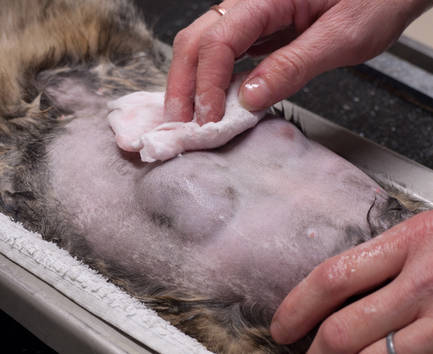Keeping your cat indoors is one of the best ways to extend their lifespan and keep them safe. However, something most cat parents don’t realize is that indoor kitties can still get skin cancer. Whether your cat lives inside, outside, or a little of both, here’s how to recognize skin cancer and malignant skin lesions in cats so that you can get quick and proper treatment.
About skin cancer and cancerous lesions or lumps in cats
Skin cancer in cats is the abnormal growth of skin cells that can show up as lumps, bumps, or spots. Some types of skin cancer can grow very quickly and spread to other parts of the body, others are slower growing and tend to stay local. Many skin cancers in cats are caused and egged on by sun exposure, which can happen to cats both indoors as well as out.
Key signs that a skin lesion or lump is cancerous
Any new lump, bump, or spot on your cat’s skin warrants a veterinary diagnosis because you just can’t tell what ones are troublesome and what ones aren’t by looking at them. However, most cancerous lumps and bumps will have some tell-tale signs:
- Fast growing: they show up suddenly and grow quickly
- Irregular shape: the borders of the lumps aren’t smooth and clean
- Change in color: cancerous bumps often have a different color than the normal skin around them
- Ulcerated or scaly: cancerous lumps may bleed, ooze, or the skin may be dry and scaly
- Wounds that don’t heal: similar to ulcerated lumps, skin cancer in cats may appear as a wound that just won’t go away
What does skin cancer or cancerous lumps in cats look like? [with pictures]
Skin cancer and cancerous lumps in cats come in many forms, most of which relate to sun exposure, genetics, chronic irritation, or injury. Those forms include:
1. Squamous cell carcinoma
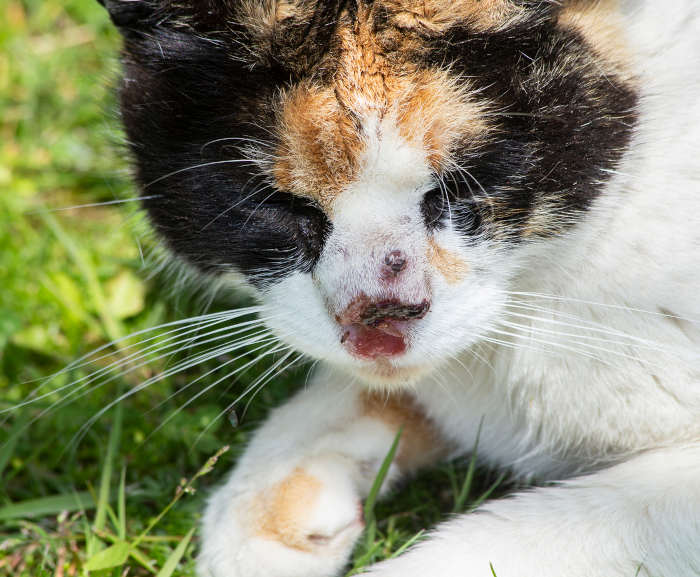
This type of skin cancer often shows up in the lighter-haired parts of light-colored cats. Squamous cell carcinoma is closely linked to sun exposure and will start out as an oozy, scaly wound on the nose, ears, or around the eyes. It is often itchy and will spread locally very quickly making it difficult to remove.
2. Mast cell tumors
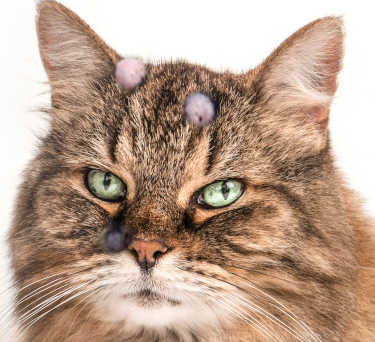

Mast cells are found throughout the body, so it should be no surprise that mast cell tumors can also pop up nearly anywhere. However, they tend to congregate to the head, neck, and legs in middle aged cats. They may come as one firm, pink lump or many. About ¼ of mast cell tumors are malignant and will spread if not treated. The more mast cell tumors a kitty has, the more guarded the prognosis.
3. Fibrosarcoma
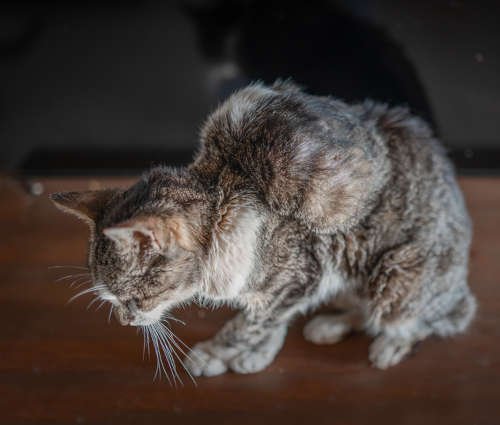
Fibrosarcomas are cancerous lumps that come from connective tissue, which is all over the body, making any area fair game. However, we most commonly see these as lumps that pop up where a kitty has had an injection, such as a vaccination. They are firm bumps that grow quickly, aren’t easily moved around, and are capable of spreading to other areas of the body. Surgical removal is the best treatment. You can view several pictures on ABCD Cat Vets or learn more about fibrosarcomas in cats.
4. Basal cell tumors
Basal cell tumors are commonly benign, flattened, hairless lumps that don’t spread so are not usually a problem unless they become ulcerated and infected. These bumps show up on older kitty’s faces, necks, and shoulders, are firm but easily moved. Removal may be necessary if a cat starts to be bothered by them. Rarely, these tumors can be malignant and will require removal. View pictures of basal cell tumors on Vet Lexicon.
5. Others
Less commonly, cats can be affected by melanoma, histiocytomas, cutaneous lymphomas, and lipomas. Some of these are very serious and some are no big deal, but you won’t be able to tell which is which without a proper veterinary diagnosis.

Growth that looks like a tumor
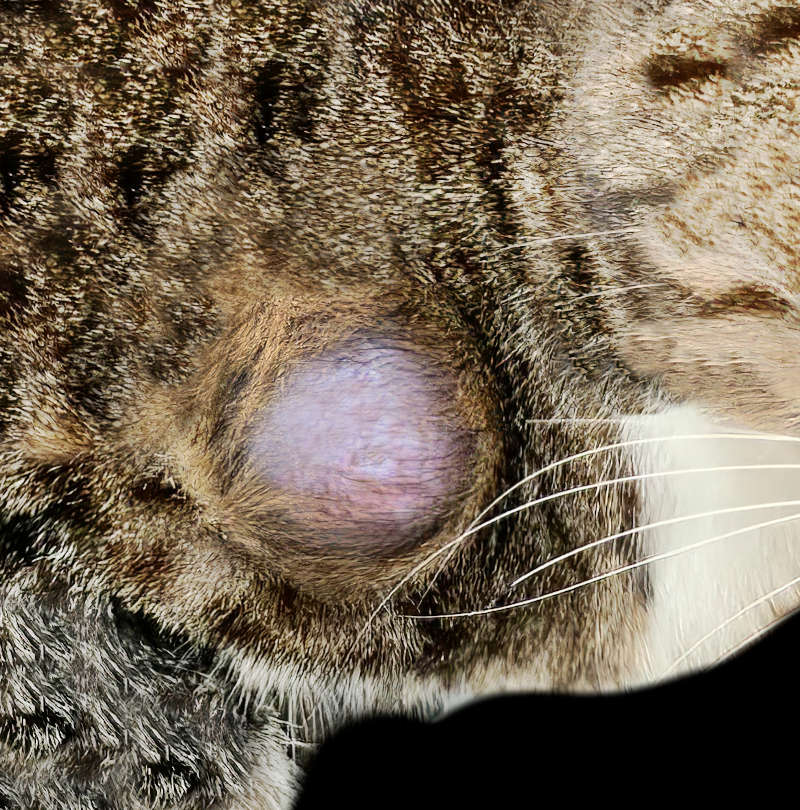
Are there other signs of skin cancer in cats?
Of course, the most common and often first sign of skin cancer in cats is a lump. But finding those lumps can be easier said than done, especially if your kitty has long or thick hair. Instead you may notice any of the following:
- Itchiness
- Excessive licking
- Decreased appetite
- Lethargy
- Hair loss
What to do when you discover a lump or bump on your cat
Any vet will tell you that the appearance of any new lump, bump, or spot warrants a veterinary visit. You just never know what could turn out to be a nasty bump and what lump is no big deal. It’s especially important to get to your vet with hast if a lump suddenly appears, grows quickly, or changes shape, size or color. Of course, your kitty will want you to take them to the vet if there are also showing any other signs of not eating, lethargy, oozing wounds, or itching and irritation.
If instead, your notice a small lump on your kitty that doesn’t seem to bother them and doesn’t seem to grow or change, you may decide to wait until your next regularly scheduled veterinary appointment to have it checked out.
How is skin cancer diagnosed and treated?
Your vet is going to want to be informed of any new lumps or changes in your cat’s skin. This is so they can get a proper diagnosis to decide which treatment plan is best for your kitty.
Diagnosis
Since skin cancer can’t be diagnosed based on appearance alone, your vet is going to need to get a sample of the lump or spot. To do this they may make an impression of the lump on a microscope slide, use a needle and syringe to get cells from the inside, or take a small piece of the lump called a biopsy. When these samples are viewed under a microscope, it will show your vet what your cat’s lump is made of and where to go from there.
Along with getting a sample of the lump, your vet may also run bloodwork or take x-rays to find out if the cancer has spread to other parts of the body.
Treatment
Most of the time your vet is going to recommend surgically removing any skin tumor as long as the lump is in a feasible area. They may also recommend chemotherapy or radiation depending on the propensity of the tumor to spread.
Cost
Different types of skin cancers are, well, different making estimating costs difficult. However, for a general exam with some bloodwork and some form of tumor sampling will cost you around $100-$300 or more. If surgery +/- a follow-up treatment of chemo or radiation is needed, look to pay $600-$1,500 or more in addition.
Learn more:

